four wheel drive CHEVROLET S10 1996 2.G Owners Manual
[x] Cancel search | Manufacturer: CHEVROLET, Model Year: 1996, Model line: S10, Model: CHEVROLET S10 1996 2.GPages: 375, PDF Size: 20.73 MB
Page 5 of 375
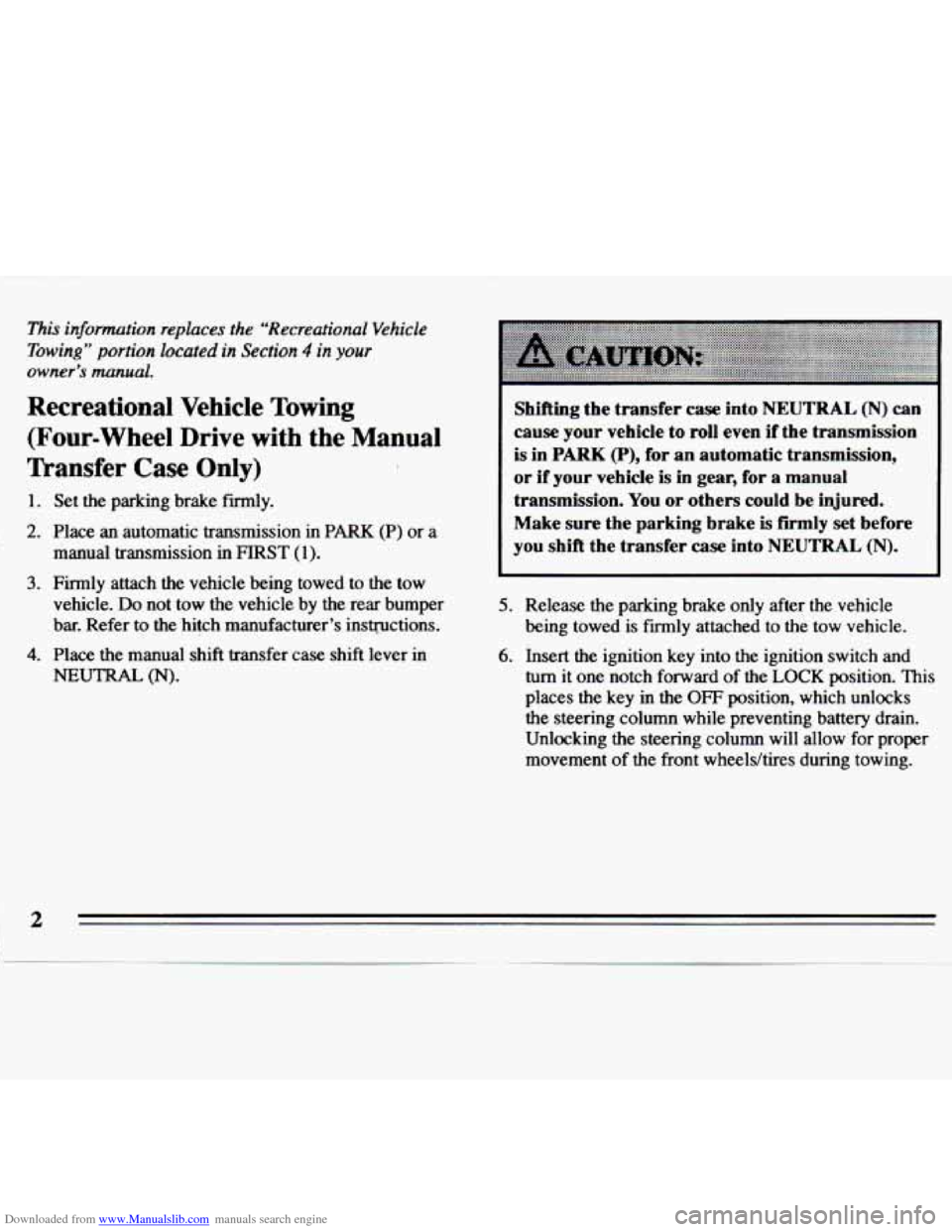
Downloaded from www.Manualslib.com manuals search engine This infurmation replaces the “Recreational Vehicle
Towing” portion located in Section 4 in your
owner’s manual.
Recreational Vehicle Towing
(Four-wheel Drive with the Manual
Transfer
Case Only)
1. Set the parking brake fmly.
2. Place an automatic transmission in PARK (P) or a
3. Firmly attach the vehicle being towed to the tow
manual transmission in FIRST (1).
vehicle. Do not tow the vehicle by the rear bumper
bar. Refer to the hitch manufacturer’s insmctions.
4. Place the manual shift transfer case shift lever in
NEUTRAL (N).
Shifting the transfer case into NEUTRAL (N) can
cause your vehicle to
roll even if the transmission
is in PARK (P), for an automatic transmission,
or if your vehicle is in gear, for a manual
transmission.
You or others could be injured.
Make sure the parking brake is firmly
set before
you
shift the transfer case into NEUTRAL (N).
5. Release the parking brake only after the vehicle
being towed is fiily attached to the tow vehicle.
6. Insert the ignition key into the ignition switch and
turn it one notch forward of the LOCK position. This
places the key
in the OFF position, which unlocks
the steering column while preventing battery drain.
Unlocking the steering column will allow for proper
movement
of the front wheelshires during towing.
I I
Page 6 of 375
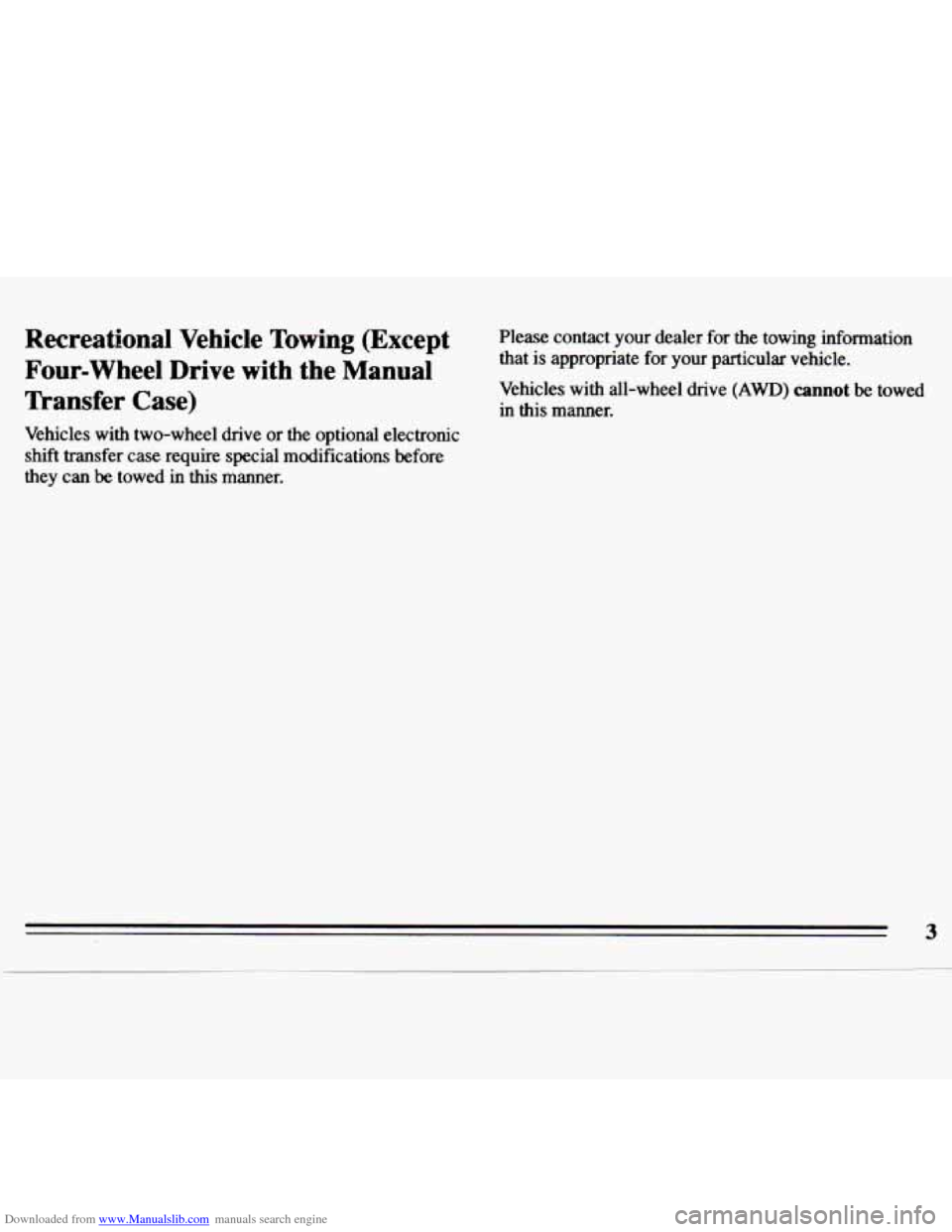
Downloaded from www.Manualslib.com manuals search engine Recreational Vehicle Towing (Except
Four-wheel Drive with the Manual
Transfer Case) Please contact your dealer for the towing information
that is appropriate for your particular vehicle.
Vehicles with all-wheel drive
(AWD) cannot be towed
in this manner.
Vehicles with two-wheel drive or the optional electronic
shift transfer case require special modifications before
they can
be towed in this manner.
3
Page 66 of 375
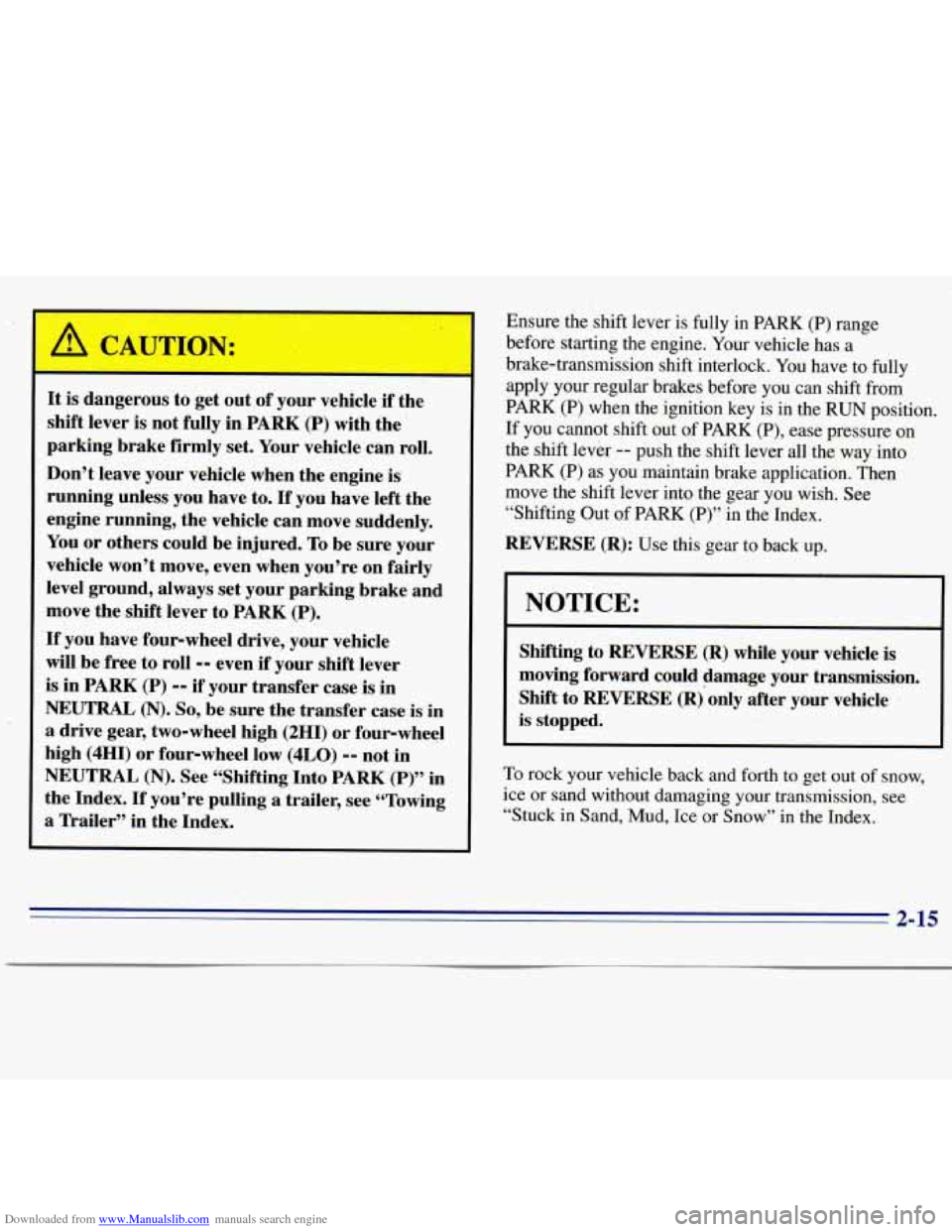
Downloaded from www.Manualslib.com manuals search engine It is dangerous to get out of your vehicle if the
shift lever
is not fully in,PARK (P) with the ’
parking brake firmly set. Your vehicle can roll.
Don’t leave your vehicle when the engine is
running unless you have to.
If you have left the
engine running, the vehicle can move suddenly.
You or others could be injured. To be sure your
vehicle won’t move, even when you’re on fairly
level ground, always set your parking brake and
move the shift .lever to PARK
(P).
If you have four-wheel drive, your vehicle
will be free to roll
-- even .if your shift lever
is in PARK (P) -- if your transfer case is in
NEUTRAL (N). So, be sure the transfer case is in
a drive gear, two-wheel high (2HI) or four-wheel
high (4HI) or four-wheel low (4LO)
-- not in
NEUTRAL
(N). See “Shifting Into PARK (P)” in
the Index.
If you’re pulling a trailer, see “Towing
a Trailer” in the Index. Ensure’ the shift lever
is €ully in PARK (P) range
before starting the engine. Your vehicle has a
brake-transmission shift interlock. You have to fully
apply your regular brakes before you can shift from
PARK (P) when the ignition key is
ii.1 the RUN position.
If you cannot shift out of PARK (P), ease pressure on
the shift lever
-- push the shift lever all the way into
PARK (P) as you maintain brake application. Then
move the shift lever into the gear you wish. See
“Shifting Out of PARK (P)” in the Index.
REVERSE (R): Use this gear to back up.
NOTICE:
Shifting to REVERSE (R) while your vehicle is
moving forward could damage your transmission.
Shift to REVERSE (Rjonly after your vehicle
is stopped.
To rock your vehicle back and forth to get out of snow,
ice
or sand without damaging your transmission, see
“Stuck in Sand, Mud, Ice
or Snow” in the Index.
2-15
Page 70 of 375
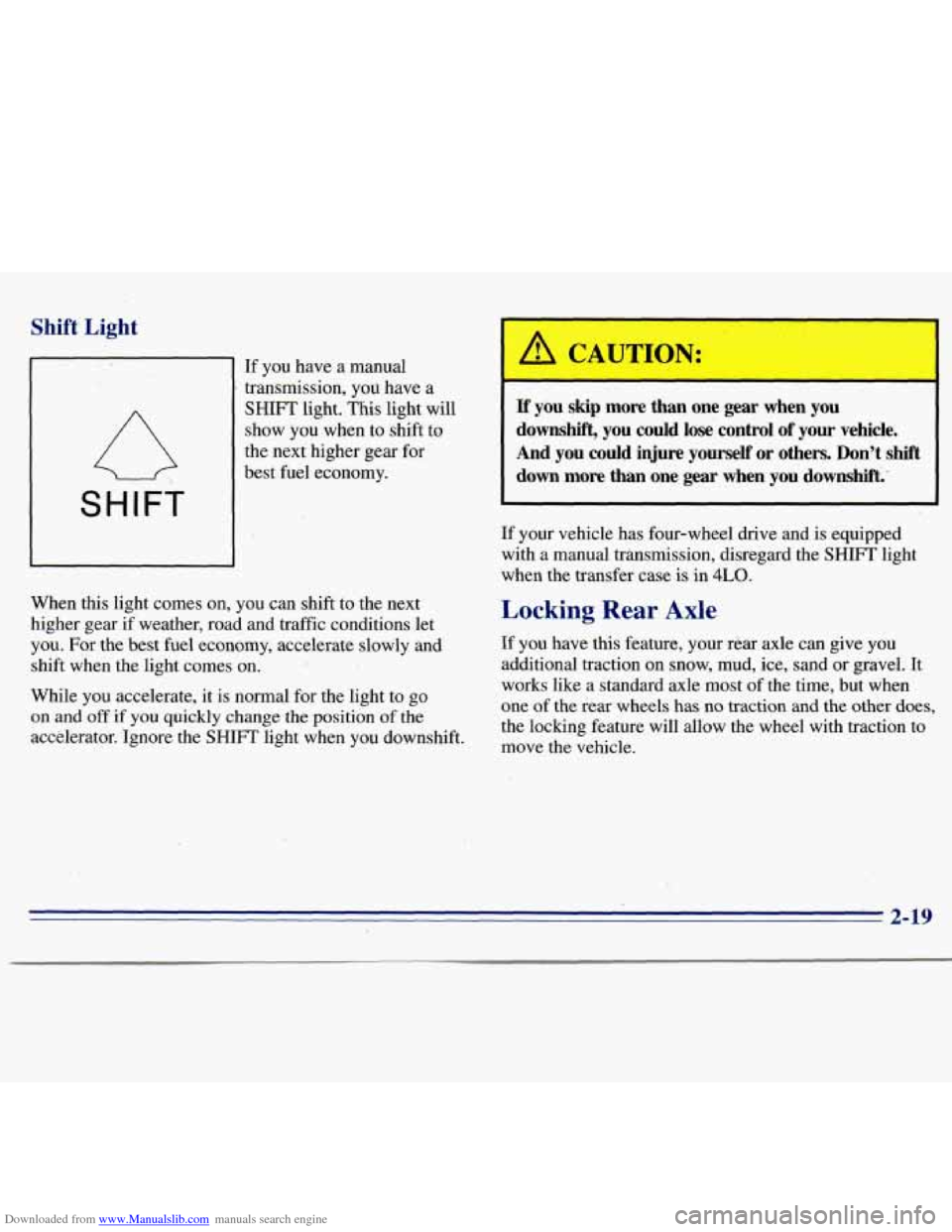
Downloaded from www.Manualslib.com manuals search engine Shift Light
SHIFT
If you have a manual
transmission, you have a
SHIFT light. This light will
show you when to shift
to
the next higher gear for
best fuel economy.
When this light comes on,
you can shift to the next
higher gear
if weather, road and traffic conditions let
you.
For the best fuel economy, accelerate slowly and
shift when
the light comes on.
While you accelerate, it is normal for the light to go
on
and off if you quickly change the position of the
accelerator. 'Ignore the SHIFT light when you downshift.
a CAUTION:
If you skip more than one gear when you
downshift, you could lose' control of your vehicle.
And
you could injure yourself' or others. Don't shift
down more than one gear when you downshift.'
If your vehicle has four-wheel drive and is equipped
with a manual transmission, disregard the
SHIFT light
when the transfer case
is in 4LO.
Locking Rear Axle
If you have this feature, your rear axle can give you
additional traction on snow, mud, ice, sad or gravel. It
works like a standard axle most of the time, but when
one
of the rear wheels has no traction and the other does,
the locking feature will allow the wheel with traction to
move the vehicle.
Page 71 of 375
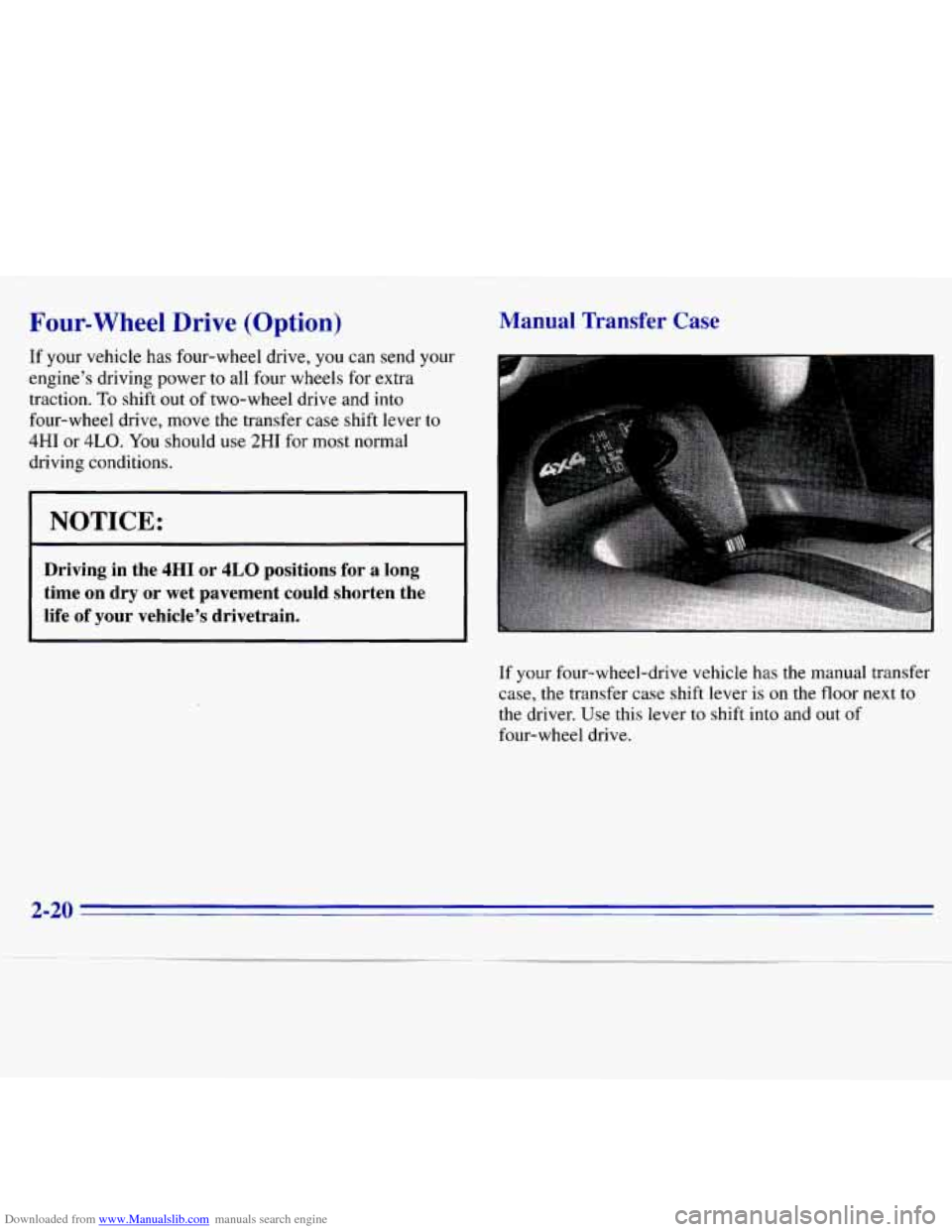
Downloaded from www.Manualslib.com manuals search engine Four-wheel Drive (Option)
If your vehicle has four-wheel drive, you can send your
engine’s driving power to all four wheels for extra
traction.
To shift out of two-wheel drive and into
four-wheel drive, move the transfer case shift lever to
4HI or 4LO. You should use 2HI for most normal
driving conditions.
NOTICE:
Driving in the 4HI or 4LO positions for a long
time on dry or wet pavement could shorten the life of your vehicle’s drivetrain.
Manual Transfer Case
If your four-wheel-drive vehicle has the manual transfer
case, the transfer case shift lever is on the floor next
to
the driver. Use this lever to shift into and out of
four-wheel drive.
2-20
Page 72 of 375
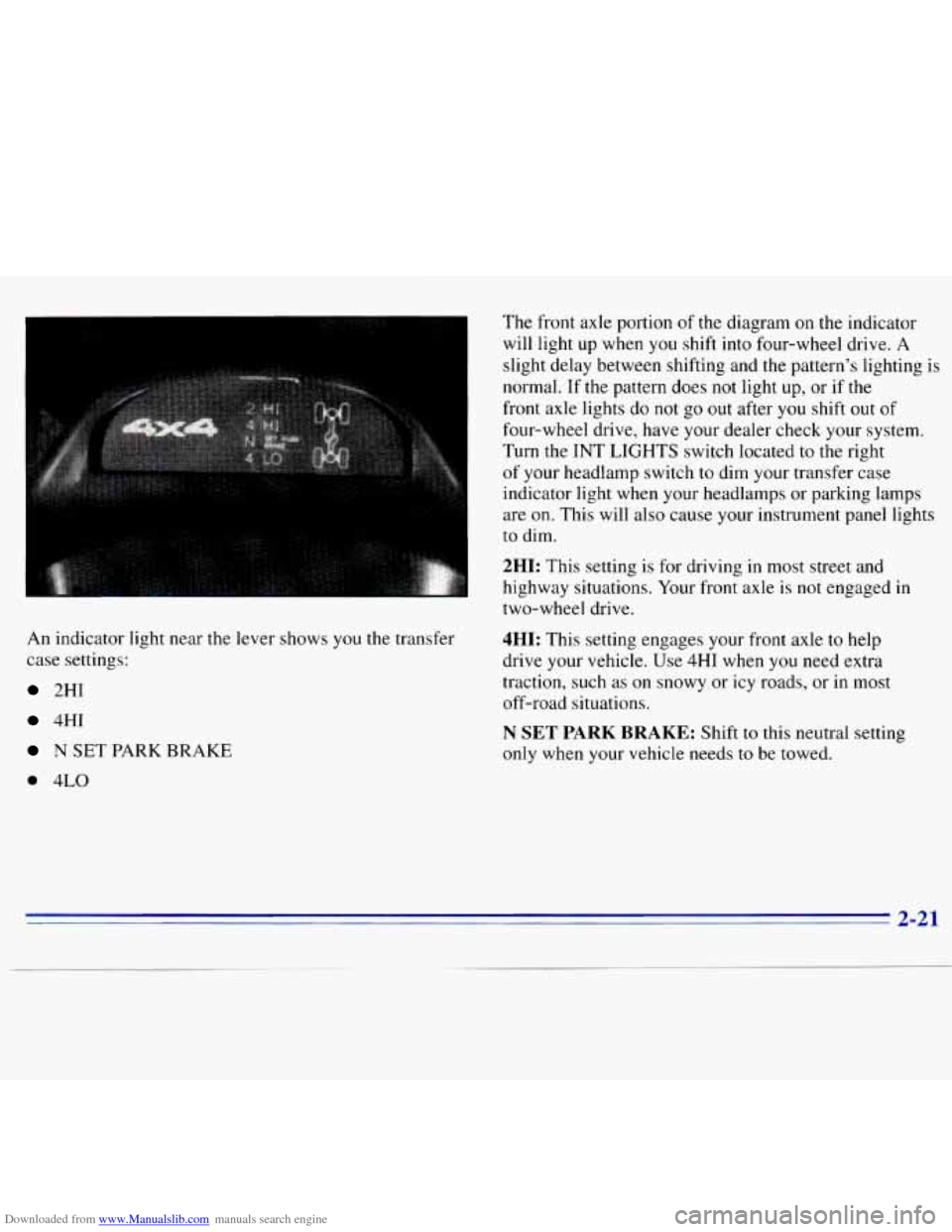
Downloaded from www.Manualslib.com manuals search engine An indicator light near the lever shows you the transfer
case settings:
2HI
4HI
N SET PARK BRAKE
0 4LO
The front axle portion of the diagram on the indicator
will light up when you shift into four-wheel drive.
A
slight delay between shifting and the pattern’s lighting is
normal. If the pattern does not light up, or if
the
front axle lights do not go out after you shift out of
four-wheel drive, have your dealer check your system.
Turn the INT
LIGHTS switch located to the right
of your headlamp switch to dim your transfer case
indicator light when your headlamps or parking lamps
are on. This will also cause your instrument panel lights
to dim.
2HI: This setting is for driving in most street and
highway situations. Your front axle is not engaged
in
two-wheel drive.
4HI: This setting engages your front axle to help
drive your vehicle. Use
4HI when you need extra
traction, such as
on snowy or icy roads, or in most
off-road situations.
N SET PARK BRAKE: Shift to this neutral setting
only when your vehicle needs to be towed.
2-21
Page 73 of 375
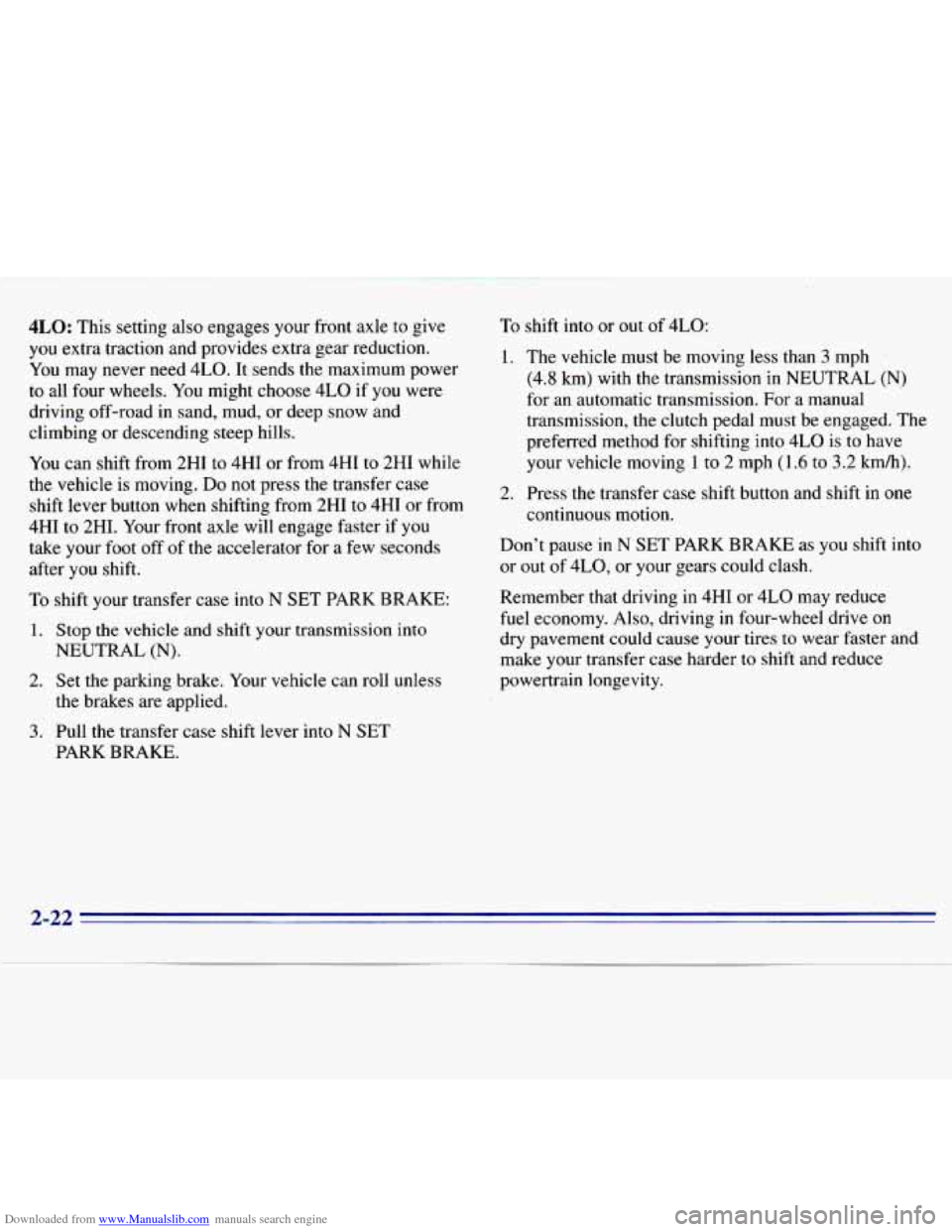
Downloaded from www.Manualslib.com manuals search engine 4LO: This setting also engages your front axle to give
you extra traction and provides extra gear reduction.
You may never need 4LO. It sends the maximum power
to all four wheels. You might choose 4LO
if you were
driving off-road in sand, mud, or deep snow and
climbing or descending steep hills.
You can shift from 2HI to 4HI or from 4HI to 2HI while
the vehicle is moving.
Do not press the transfer case
shift lever button when shifting from 2HI to 4HI
or from
4HI to 2HI. Your front axle will engage faster
if you
take your foot
off of the accelerator for a few seconds
after you shift.
To shift your transfer case into
N SET PARK BRAKE:
1. Stop the vehicle and shift your transmission into
2. Set the parking brake. Your vehicle can roll unless
NEUTRAL
(N).
the brakes
are applied.
3. Pull the transfer case shift lever into N SET
PARK BRAKE.
To shift into or out of 4LO:
1. The vehicle must be moving less than 3 mph
(4.8
km) with the transmission in NEUTRAL (N)
for an automatic transmission. For a ,manual
transmission, the clutch pedal must be engaged. The
preferred method for shifting into 4LO is to have
your vehicle moving 1 to 2 mph (1.6 to 3.2 km/h).
2. Press the transfer case shift button and shift in one
continuous motion.
Don’t pause in
N SET PARK BRAKE as you shift into
or out
of 4L0, or your gears could clash.
Remember that driving in 4HI or
4LO may reduce
fuel economy. Also, driving in four-wheel drive
on
dry pavement could cause your tires to wear faster and
make your transfer case harder to shift and reduce
powertrain longevity.
2-22
Page 74 of 375
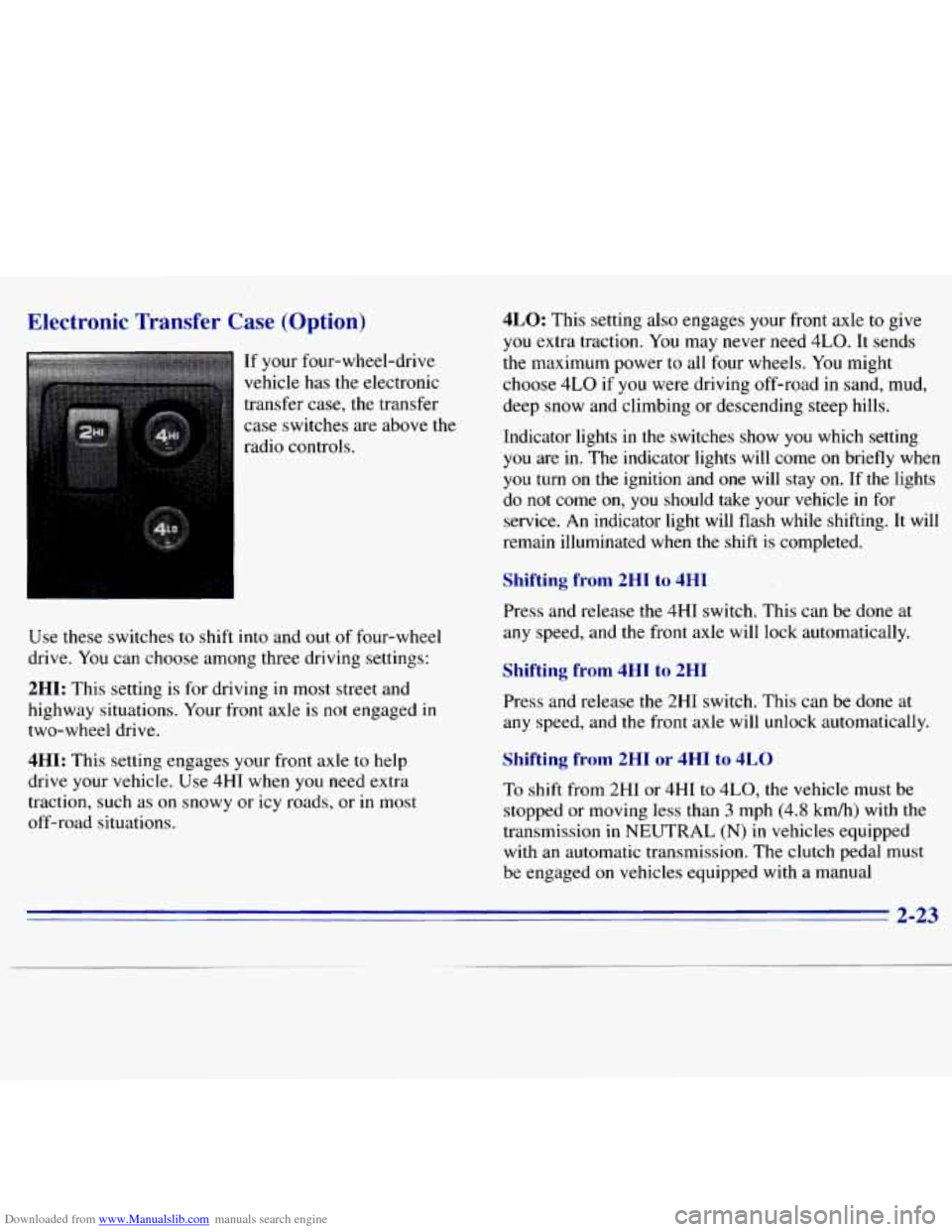
Downloaded from www.Manualslib.com manuals search engine Electronic Transfer Case (Option)
If your four-wheel-drive
vehicle has the electronic
transfer case, the transfer case switches are above the
radio controls.
Use these switches
to shift into and out of four-wheel
drive. You can choose among three driving settings:
2HI: This setting is for driving in most street and
highway situations. Your front axle is not engaged in
two-wheel drive.
4HI: This setting engages your front axle to help
drive your vehicle.
.Use 4HI when you need extra
traction, such as on snowy or icy roads, or
in most
off-road situations.
4LO: This setting also engages your front axle to give
you extra traction. You may never need
4LO. It sends
the maximum power to all four wheels.
You might
choose
4LO if you were driving off-road in sand, mud,
deep snow and climbing or descending steep hills.
Indicator lights in the switches show
you which setting
you are in. The indicator lights will come on briefly when
you turn on the ignition and one will stay on. If the lights
do
not come on, you should take your vehicle in for
service.
An indicator light will flash while shifting. It will
remain illuminated when
the shift is completed.
Shifting from 2HI to 4HI
Press and release the 4HI switch. This can be done at
any speed, and the front axle will lock automatically.
Shifting from 4HI to 2HI
Press and release the 2HI switch. This can be done at
any speed, and the front axle will unlock automatically.
Shifting from 2HI or 4HI to 4LO
To shift from 2HI or 4HI to 4L0, the vehicle must be
stopped or moving less than
3 mph (4.8 kmh) with the
transmission
in NEUTRAL (N) in vehicles equipped
with an automatic transmission. The clutch pedal
must
be engaged on vehicles equipped with a manual
2-23
Page 77 of 375
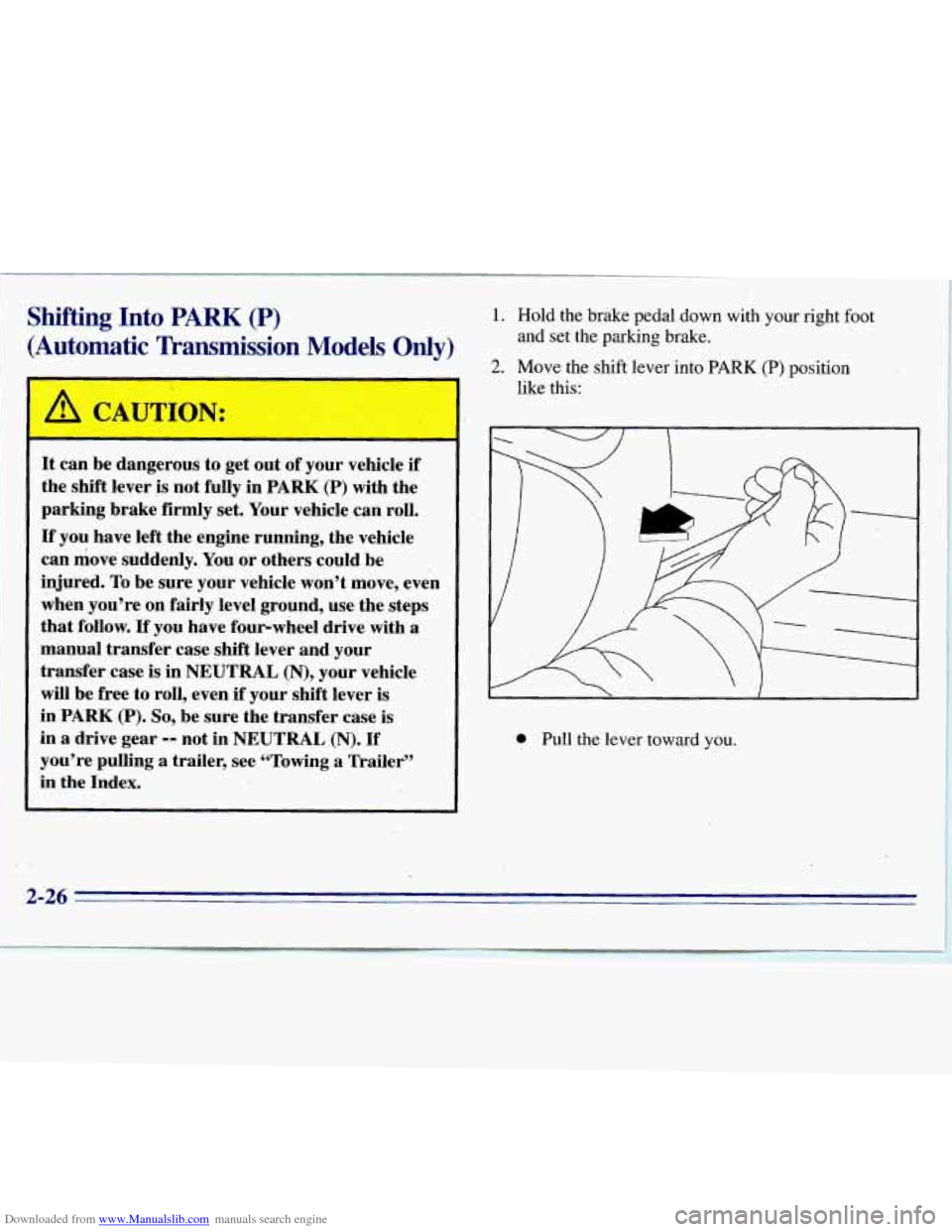
Downloaded from www.Manualslib.com manuals search engine Shifting Into PARK (P)
(Automatic Tkansmission Models Only)
1. Hold the brake pedal down with your right foot
2. Move the shift lever into PARK (P) position
and set the parking brake.
..
It can be dangerous to get out of your vehicle if
the shift lever
is not fully in PARK (P) with the
parking. brake
firmly set. Your vehicle can roll.
If you have left the engine running, the vehicle
can move suddenly.
You or others could be
injured. To be sure your vehicle won’t move, even
when you’re on
fairly level ground, use the steps
that follow.
If you have four-wheel drive with a
manual transfer case shift lever and your
transfer case
is in NEUTRAL (N), your vehicle
will be free to roll, even
if your shift lever is
in
PARK (P). So, be sure the transfer case is
in
a drive gear -- not in NEUTRAL.(N). If
you’re pulling a trailer, see “Towing a Trailer”
in the Index. like this:
I
0 Pull the lever toward you.
2-26
!
Page 78 of 375
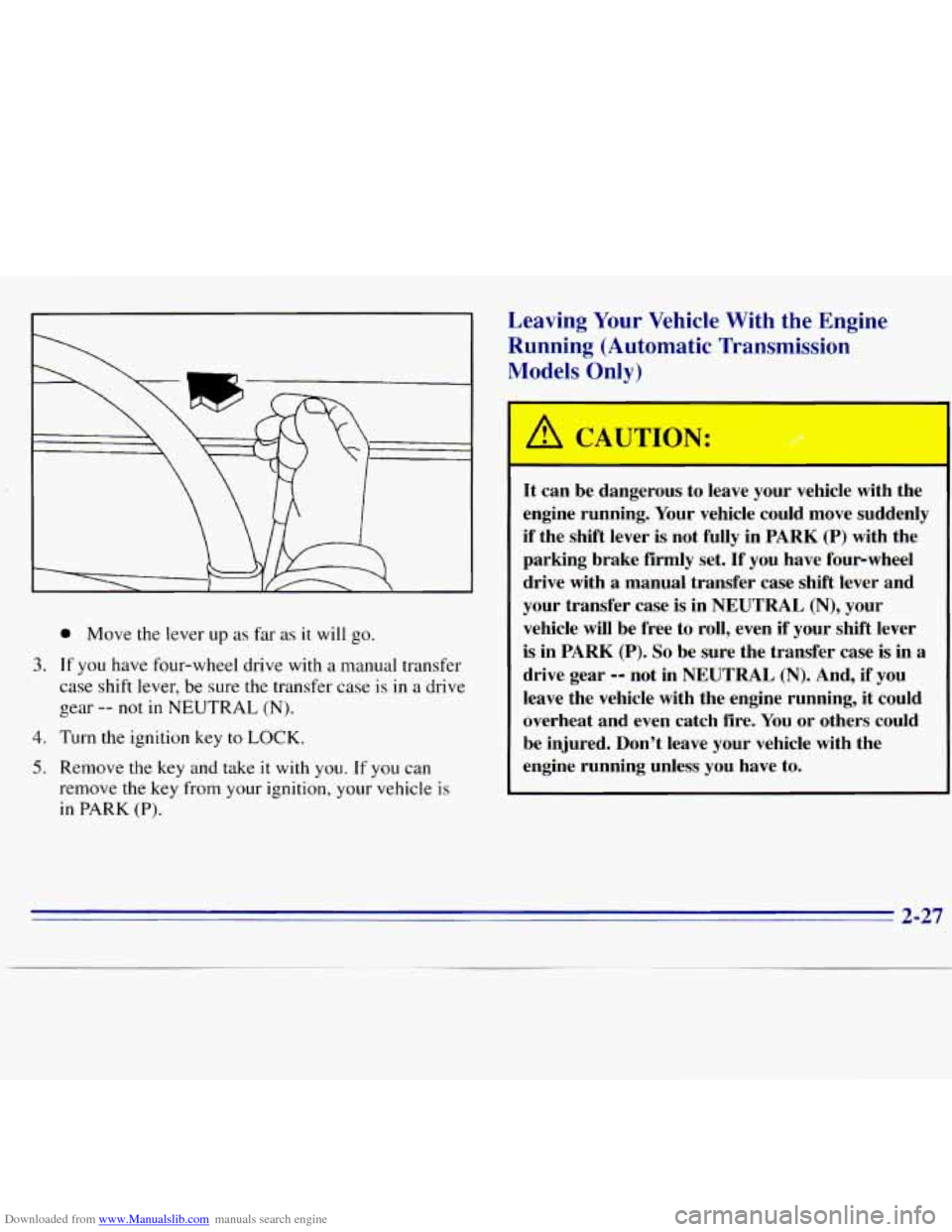
Downloaded from www.Manualslib.com manuals search engine Leaving Your Vehicle With the Engine
Running (Automatic Transmission
Models
0 lv)
@ Move the lever up as far as it will go.
3. If you have four-wheel drive with a manual transfer
case shift lever, be sure the transfer case is in
a drive
gear
-- not in NEUTRAL (N).
4. Turn the ignition key to LOCK.
5. Remove the key and take it with you. If you can
remove the key from
your ignition, your vehicle is
in PARK (P).
A CAUTION:
It can be dangerous to leave your vehicle with the
engine running. Your vehicle could move suddenly
if the shift lever is not fully in PARK
(P) with the
parking brake firmly set. If you have four-wheel
drive with
a manual transfer case shift lever and
your transfer case is in NEUTRAL
(N), your
vehicle will be free to roll, even
if your shift lever,
is in PARK (P).
So be sure the transfer case is in a
drive gear -9 not in NEUTRAL (N). And, if you
leave the vehicle with the engine running, it could
overheat and even catch fire. You or others could
be injured. Don’t leave your vehicle with the
engine running unless you have to.
2-27